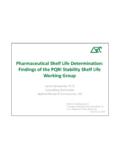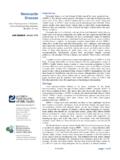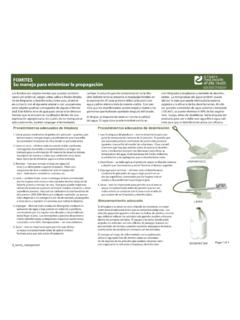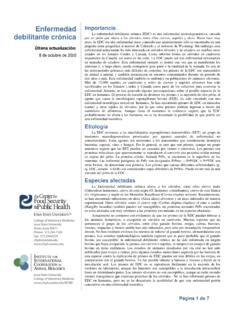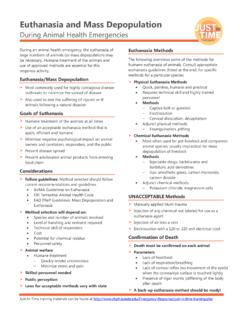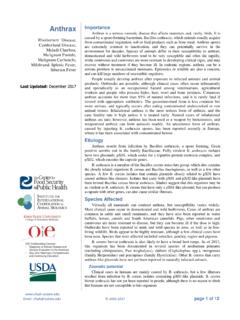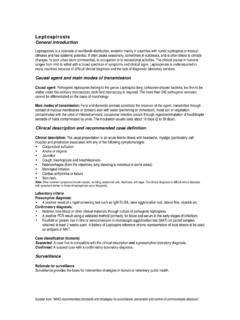Transcription of African Swine Fever - Iowa State University
1 African Importance African Swine Fever is a serious, highly contagious, viral disease of pigs. African Swine Fever Swine Fever virus (ASFV) can spread very rapidly in pig populations by direct or indirect contact. It can persist for long periods in uncooked pig products, facilitating Peste Porcine Africaine, its introduction into new areas. This virus can also become endemic in feral or wild suids, and transmission cycles between these animals and Ornithodoros ticks can Fiebre Porcina Africana, complicate or even prevent eradication. ASFV isolates vary in virulence from highly Pestis Africana Suum, pathogenic strains that cause near 100% mortality to low virulence isolates that can Maladie de Montgomery, be difficult to diagnose.
2 There is no vaccine or treatment. Warthog Disease, African Swine Fever is a serious problem in many African countries. Changes in Afrikaanse Varkpes, production practices and increasing globalization have also increased the risk of its Afrikanische Schweinepest introduction into other regions. Past outbreaks occurred in Europe, South America and the Caribbean, and the cost of eradication was significant. The Swine herds of Malta and the Dominican Republic were completely depopulated during outbreaks in these countries. In Spain and Portugal, ASFV became endemic in the 1960s and Last Updated: October 2015 complete eradication took more than 30 years.
3 It still remains present on the island of Sardinia. In 2007, Africa Swine Fever was introduced into the Caucasus region of Minor update: October 2018 Eurasia, where it has spread widely among wild boar and domesticated pigs. This virus has caused outbreaks in pigs as far west as the easternmost countries of the , and it has also been detected in wild boar in Iran. In 2018, African Swine Fever was detected in multiple locations in China. Etiology African Swine Fever results from infection by the African Swine Fever virus, which belongs to the genus Asfivirus in the family Asfarviridae. More than 20. genotypes of ASFV have been identified, most from wildlife cycles in Africa.
4 The virus introduced into the Caucasus belongs to genotype II, while viruses endemic in Sardinia belong to genotype I. ASFV isolates differ greatly in virulence, from highly pathogenic viruses that kill most pigs to strains that result only in seroconversion. Species Affected African Swine Fever affects members of the pig family (Suidae). Species that can be infected include domesticated Swine , Eurasian wild boars (Sus scrofa scrofa), warthogs (Phacochoerus spp.), bush pigs (Potamochoerus larvatus and Potamochoerus porcus) and giant forest hogs (Hylochoerus spp.). Warthogs and bush pigs, which are generally asymptomatic, are thought to be wildlife reservoirs for the virus in Africa.
5 Some older reviews and textbooks suggest that peccaries (Tayassu spp.) may also become infected without clinical signs, although one attempt to infect collared peccaries (Tayassu tajacu) in 1969 was unsuccessful. Recent reviews State that that peccaries are not susceptible. Zoonotic potential There is no evidence that ASFV infects humans. Geographic Distribution African Swine Fever is endemic in most of sub-Saharan Africa including the island of Madagascar. Outbreaks have been reported periodically outside Africa. The virus was eventually eradicated in most cases, although it remains endemic on the island of Sardinia (Italy) in the Mediterranean.
6 In 2007, ASFV was introduced into the Caucasus region of Eurasia, via the Republic of Georgia, and it has spread to domesticated pigs and/or wild boars in a number of countries in this region. As of 2015, infections had been reported as far west as Lithuania, Latvia and Poland. Viruses that apparently originated from this outbreak have also been found in wild boar in the Middle East (Iran). Transmission African Swine Fever can be transmitted either with or without tick vectors as intermediaries. After direct (non-tickborne) contact with the virus, ASFV is mainly thought to enter the body via the upper respiratory tract. This virus has been found in Email: 2003-2016 page 1 of 6.
7 African Swine Fever all secretions and excretions of sick domesticated pigs, with Disinfection particularly high concentrations in oronasal fluid. There may, Many common disinfectants are ineffective against however, be species differences among the Suidae. For ASFV; care should be taken to use a disinfectant specifically instance, concentrations of ASFV appear to be much lower in approved for this virus. Sodium hypochlorite, citric acid (1%). adult warthogs, compared to pigs, and adult warthogs might and some iodine and quaternary ammonium compounds are not transmit the virus by direct contact. In pigs, aerosolized reported to destroy ASFV on some nonporous surfaces.
8 In viruses may contribute to transmission within a building or one recent experiment, either 2% citric acid or higher farm, although current evidence suggests that this only concentrations of sodium hypochlorite ( , 2000 ppm). occurs over relatively short distances. Because ASFV can could disinfect the virus on wood; however, citric acid was persist in blood and tissues after death, it is readily spread by more effective. feeding uncooked swill that contains tissues from infected Unprocessed meat must be heated to at least 70 C for animals. Some reports suggest that the cannibalism of dead 30 minutes to inactivate ASFV; 30 minutes at 60 C is pigs may be important in transmission.
9 In addition, massive sufficient for serum and body fluids. This virus can also be environmental contamination may result if blood is shed inactivated by pH < or > in serum-free medium. during necropsies or pig fights, or if a pig develops bloody diarrhea. How long pigs can remain infected is still uncertain. Incubation Period Several studies have reported finding ASFV in the tissues of The incubation period is 5 to 21 days after direct domesticated pigs for as long as 3 to 6 months, and virus contact with infected pigs, but it can be less than 5 days shedding and transmission for at least 70 days after after exposure to ticks. Acute disease typically appears in experimental inoculation.
10 However, there are also studies 3 to 7 days. where pigs could not transmit the virus for longer than a month. Currently, there is no evidence that the virus persists Clinical Signs long-term in a latent State . African Swine Fever can be a peracute, acute, subacute ASFV can spread on fomites, including vehicles, feed or chronic disease. Severe cases that affect large numbers of and equipment. In feces kept at room temperature, this virus animals may be readily recognized; however, some herds was estimated to survive for several days in some reports, develop milder clinical signs that are easily confused with and for at least 11 days in one study where the sample was other diseases.

